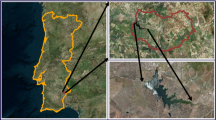Abstract
The development of a space-time approach in modeling to display the spatial (including aquatic, in the case of reservoirs) differentiation of objects of study is important for geography. A model of the aquatic ecosystem has been created to assess the course of eutrophication, one of the main causes of the deterioration of the ecological state of inland and coastal waters. This simulation model makes it possible to analyze and predict long-term trends in the development of hydro biogeocenoses. The model reproduces the main intra-annual and intradaily changes in the ecosystems of reservoirs. The novelty of the study consists of its combination of methods for modeling structural and dynamic processes and cycles of transformation of biogeochemical elements in a spatially heterogeneous ecosystem of the reservoir. For this purpose, the Biogen simulation model is used, on the basis of which it was previously possible to reproduce the long-term trend of eutrophication of the Novosibirsk Reservoir. Changes in water quality under the influence of natural and anthropogenic factors are analyzed and predicted using the example of 1981 data for the abovementioned reservoir. The significant excess of phytoplankton biomass in the deepwater zone with a fast current compared to the shallow lagoon in the central part of the reservoir, which is observed every year, is explained. The reason for the regular excess of phytoplankton biomass at depth compared to the surface layer near the dam of the Novosibirsk Reservoir in August is determined. The ecohydrological mechanism of these cases of unusual spatial distribution of phytoplankton is explained and evaluated. The reaction of the ecosystem to a possible change in the operation mode of the hydropower facility is predicted.




Similar content being viewed by others
REFERENCES
Carneiro, C., Anoli, C.V., Cunha, C.L.N., and Gobbi, E.F., A Guide to Reservoir Eutrophication: Preventive Management: An Applied Example of Integrated Basin Management Interdisciplinary Research, London: IWA Publishing, 2014.
Datsenko, Yu.S., Evtrofirovanie vodokhranilishch. Gidrologo-gidrokhimicheskie aspekty (Eutrophication of Reservoirs. Hydrological and Hydrochemical Aspects), Moscow: GEOS, 2007.
Kobanova, G., Takhteev, V., Rusanovskaya, O., and Timofeyev, M., Lake Baikal ecosystem faces the threat of eutrophication, Int. J. Ecol., 2016, vol. 2016, pp. 1–7. https://doi.org/10.1155/2016/6058082
The Great Lakes Restoration Initiative: Background and Issues. https://www.everycrsreport.com/reports/ R43249.html#_Toc370914293. Cited July 6, 2022.
Boulion, V.V., A System for assessing and forecasting the bioproductivity of lacustrine-type ecosystems, Water Resour., 2020, vol. 47, no. 3, pp. 459–467. https://doi.org/10.1134/S0097807820030021
Martin, R., Radosavljevic, S., and Schlüter, M., Short-term decisions in lake restoration have long-term consequences for water quality, Reg. Envir. Change, 2020, vol. 20, no. 101, pp. 1–12. https://doi.org/10.1007/s10113-020-01643-4
Vinçon-Leite, B. and Casenave, C., Modelling eutrophication in lake ecosystems: A review, Sci. Total Envir., 2019, vol. 651, part 2, pp. 2985–3001. https://doi.org/10.1016/j.scitotenv.2018.09.320
S.E. Jørgensen, S.E., Nielsen, S.N., and Fath, B.D., Recent progress in systems ecology, Ecol. Modelling, 2016, vol. 319, pp. 112–118. https://doi.org/10.1016/j.ecolmodel.2015.08.007
Bulgakov, N.G., Maksimov V.N., Levich A.P., Yuzbekov A.K., and Risnik D.V., Ecological forecast of changes in the state of aquatic ecosystems, Usp. Sovrem. Biol., 2010, vol. 130, no. 5, pp. 435–445.
Jørgensen, S.E., Structural dynamic model, Ecol. Modelling, 1986, vol. 31, nos. 1–4, pp. 1–9.
Jørgensen, S.E., Structurally dynamic models of lakes, Int. J. Design & Nat. Ecodyn., 2012, vol. 7, no. 2, pp. 117–139.
Tonetta, D., Staehr, P.A., Schmitt, R., and Petrucio, M.M., Physical conditions driving the spatial and temporal variability in aquatic metabolism of a subtropical coastal lake, Limnologica, 2016, vol. 58, pp. 30–40. https://doi.org/10.1016/j.limno.2016.01.006
Tskhai, A.A. and Ageikov, V.V., Simulating variations in reservoir eutrophication level by reproducing biogeochemical cycles, Water Resour., 2020, vol. 47, no. 1, pp. 105–113. https://doi.org/10.31857/S0321059620010149
Mnogoletnyaya dinamika vodno-ekologicheskogo rezhima Novosibirskogo vodokhranilishcha (Long-Term Dynamics of the Water-Ecological Regime of the Novosibirsk Reservoir), Vasil’ev, O.F, Ed., Novosibirsk: Sib. Otdel. Ross. Akad. Nauk, 2014.
Kompleksnye issledovaniya Novosibirskogo vodokhranilishcha (Comprehensive Studies of the Novosibirsk Reservoir), Podlipskii, Yu.I. and Chaikovskaya, T.S, Eds., Moscow: Gidrometeoizdat, no. 70, 1985.
Leonov, A.V., Matematicheskoe modelirovanie transformatsii soedinenii fosfora v presnovodnykh ekosistemakh (na primere oz. Balaton) (Mathematical Modeling of the Transformation of Phosphorus Compounds in Freshwater Ecosystems (On the Example of Lake Balaton)), Moscow: Nauka, 1986.
Tskhai, A.A., Ageikov, V.Yu., and Semchukov, A.N., Modeling of the spatial distribution of the components for the ecosystem of the Novosibirsk reservoir, Spatial Data Processing for Monitoring of Natural and Anthropogenic Processes, CEUR Workshop Proceeding, Novosibirsk, 2021, pp. 557–566. https://doi.org/10.25743/SDM.2021.84.73.067
Theil, H., Applied Economic Forecasting, North-Holland: Amsterdam, 1971.
Tskhai, A.A. and Ageikov, V.Yu., Disturbance of sustainability of the reservoir ecosystem: a model approach for assessing and forecasting the long-term process of eutrophication, J. Sustainable Dev. Energy, Water And Envir. Syst., 2021, vol. 9, no. 1, p. 1080327. https://doi.org/10.13044/j.sdewes.d8.0327
Alimov, A.F., Bogatov, V.V., and Golubkov, S.M., Produktsionnaya gidrobiologiya (Production Hydrobiology), St. Petersburg: Nauka, 2013.
ACKNOWLEDGMENTS
This work was carried out as part of the State Task of the Institute of Water and Environmental Problems, Siberian Branch, Russian Academy of Sciences, with support from the Russian Foundation for Basic Research and the Government of the Altai krai (Russian Federation) (18-41-220002r_a).
Author information
Authors and Affiliations
Corresponding authors
Rights and permissions
About this article
Cite this article
Tskhai, A.A., Ageikov, V.Y. Spatiotemporal Model of the Ecosystem of the Novosibirsk Reservoir. Geogr. Nat. Resour. 43 (Suppl 1), S85–S91 (2022). https://doi.org/10.1134/S1875372822050171
Received:
Revised:
Accepted:
Published:
Issue Date:
DOI: https://doi.org/10.1134/S1875372822050171




